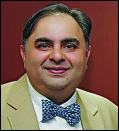Translate this page into:
What can my Professional Organization give me?

How to cite this article: Vaid NR. What can my Professional Organization give me?. APOS Trends Orthod 2013;3:129-30.
Readers of our journal are Orthodontists who are members of their respective specialty organizations. Most of the organizations serve to organize conferences, have study groups activities, do voluntary work for the society, print journals, publish newsletters and represent professional groups on international bodies.
What does all of this give to the ordinary member? A question to this effect is often asked. Let’s look at this issue a little differently.
The growth of most Professional Organizations needs to be carefully evaluated. Most modest study groups and associations have started by meeting up at the member’s offices, or clubs as a small cohesive group. Today, our orthodontic organizations follow a model where meetings are rotated every year or periodically to different venues. Hotels and convention centers today, due to increased volumes, have replaced the offices/restaurants and clubs as venues. However, have the “goals” that founded these organizations changed?
The classic model of a successful organization would perhaps be the Bombay Orthodontic Study Group. The Bombay Orthodontic Study Group formed in 1965 merged to form the Indian Orthodontic Society with just seven founder members. Today the IOS has more than 5000 (Student + Life) members, is about to organize its Golden Jubilee conference in 2015, runs a successful journal, is an affiliate of the Asian Pacific Orthodontic Society (APOS) and the World Federation of Orthodontists, has more than 25 regional study groups, has hosted an APOC and has members who contribute to the global orthodontic knowledge base. It has a governance structure where, elections are held for almost every position, which is reflective of a culture where more and more people want to be counted and contribute to the running of the organization.
How and why did this organization grow so successful? Was it playing populist cards, harboring on seniority making decisions, giving sops to its members who form an electorate or was the “goal” different?
The primary goal of all Orthodontic bodies always has been to provide a forum for scientific fraternal interactions. They did start out being a small group of likeminded professionals who desired to discuss practice management issues, clinical protocols, get peer help in preparing for Board Certifications, or find collective solutions to problems associated with specific clinical scenarios. As national organizations look at larger events, study groups or local city/ province bodies still provide a platform for CE, Clinical Pearl Presentation and interaction that can provide a forum for group clinical problem solving. It increases peer interaction and fraternal bonhomie is another advantage altogether.
Then why is it that while some bodies have grown on to becoming successful organizations, others have withered along the way. When organizations struggle to get members to attend its meetings and then slowly stop having them, leading to a silent death of the professional body, what could be the cause?
As discussed, most study groups or organizations build their foundations on scientific exchange, guided in place by progressive leadership who envision the future. When regulators who only aim to adorn positions and reward anything other than meritocracy, rule the roost, degenerative changes occur in the organization. Ayn Rand in “Atlas Shrugged, 1957, beautifully describes this phenomenon. “When you see that in order to produce, you need to obtain permission from men who produce nothing – You may know that your society is doomed.”
Most professional bodies or study groups that have grown from strength to strength, despite modest beginnings have done so because of lofty ideals, focused leadership and commitment towards their core vision and “goals.” Being focused on original goals, despite an increase in strength is critical to any group/ organization’s vibrancy. For us, the core ingredient of all professional interactions will always be scientific and small groups as well as large organizations that progress; will only do so, when this tenet is adhered to. As Bryce Lee, Secretary General: APOS, most aptly puts it “The road to our goal is less important so long as we all have the same goal in mind”.
APOS has made an effort for its member organizations, by providing a world-class journal that disseminates peer-reviewed information without any commercial agenda to it. This is its second scientific effort, after the Asian Pacific Orthodontic Congress that it hosts every 2 years; showcasing the best scientific activity the region has to offer.
Being an Association of Associations, what motivates individuals who offer voluntary services to this organization? Fraternal brotherhood, a sense of belonging to the region or the organization, a desire to provide the best possible environment for international scientific interactions, or something else!
The journal and conferences are growing in stature due to the unstinted efforts of people, who didn’t ask “what’s in it for me?”
For professionals, who still contemplate whether it’s really worth their time updating records, publishing one’s clinical or research information, share know-how with colleagues, spend a weekend attending CE events or do voluntary work for professional bodies, an interesting quote from a very senior orthodontist should provide some insight on this issue. “There have been times when I’ve felt whether it’s really worth getting my slides ready for CE events, or organizing them is worth my time, but then the take home from all these events, the new ideas and techniques from other colleagues that helps me become a better professional and a better clinician, is all worth the effort”.
Professional Organizations follow a simple principle of “what goes around comes around.” Be it leadership, voluntary work or scientific activity; remember organizations give us plenty, only if we give them unstinted efforts and commitment, a plenty!

Nikhilesh R. Vaid
Editor-in-Chief, APOS Trends in Orthodontics E-mail: orthonik@gmail.com
Source of Support:
Nil.
Conflict of Interest:
None declared.





